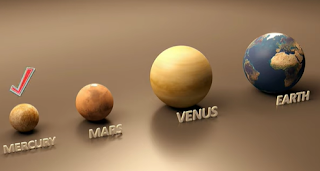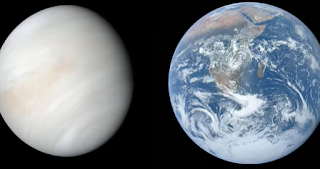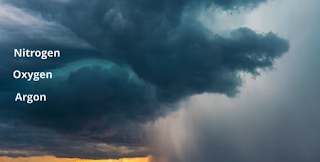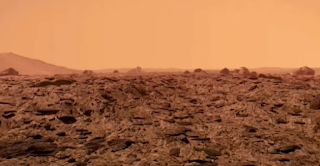Mercury is about 1/3 the size of Earth.
Mercury has a central core, a rocky mantle, and a solid crust. Mercury's surface resembles that of Earth's Moon, scarred by many impact craters resulting from collisions with meteoroids and comets. Mercury's surface temperatures are both extremely hot and cold.
Mercury has a very thin atmosphere composed mainly of oxygen,sodium, hydrogen.
It is .4 AU from the Sun so it is 40% the distance from the Sun compared to Earth.
An AU is the distance the Earth is from the Sun. This allows you to see if the planet is closer or further from the Sun than Earth.
Venus is slightly smaller than the Earth.
It’s the hottest planet in our solar system. Surface temperatures on Venus are about 900 degrees Fahrenheit (475 degrees Celsius). The surface is a rusty color and this planet has mountains and thousands of large volcanoes. The air pressure is roughly 90 times greater than the Earth’s due to its thick atmosphere.
It"s atmosphere is thick and composed of 96% carbon dioxide and 4% nitrogen.The carbon dioxide traps in heat and causes the extreme temperatures.
It is .7 Au from the sun or 70% the distance the Earth is.
The detection of phosphine recently in the atmosphere of Venus may indicate that there may be life in the atmosphere of Venus. For many years life seemed improbable on this furnace of a planet but the recent discovery of phosphine has caused scientists to rethink life on Venus.
Earth has a radius of 3959 miles.
It has a solid surface composed of canyons, mountains, volcanoes, and tectonic plates that move. It’s atmosphere is composed 78% nitrogen, 21% oxygen, 1% Argon,and less than 1% other gasses.
Earth is 1AU from the sun, which is roughly 93 million miles or 150 km from the sun.
The Earth has a huge variety of life found on it.
Mars is about ½ the size of Earth.
The surface of Mars is covered with reddish dust due to the rusting of the iron in the dust. It has seasons, a huge canyon called Valles Marineris , Mars is home to the largest volcano in the solar system, Olympus Mons.that is three times taller than Earth's Mt. Everest.There is a limited amount of water on mars found in the form of ice just under the surface in the polar regions.
Mars is 1.5 AU's from the Sun.
To date, no proof of past or present life has been found on Mars.
Jupiter is 11 times larger than the Earth and It is the largest planet.
It’s atmosphere is made up of 90% hydrogen and 10 % helium. It is famous for the red spot which is a huge storm that has been raging for 100’s of years.
The chances of life on Jupiter are very rare. The temperatures and pressures of this planet are most likely too extreme and volatile for organisms to survive.
Jupiter is 5.2 AU’s from the Sun.
Saturn is 9 times larger than Earth.
Like Jupiter, Saturn is a gas giant and therefore does not have a solid surface.
It’s atmosphere is similar to the Sun and Jupiter, over 95 percent hydrogen and 3% helium.
Saturn is 9.6 AU’s from the Sun.
Saturn cannot support life.
Uranus is roughly 4 times the size of the Earth.
Uranus does not have a solid surface. The average temperature of Uranus' surface is about -353 °F. It consists mainly of clouds made of ice crystals of water, methane and some ammonia. It does have a small solid core.
It’s atmosphere is made up roughly 2% methane, 80% hydrogen, and 15% helium.
Uranus is 19.2 AU’s from the Sun.
There is not life on Uranus.
Neptune is four times the size of the Earth.
It’s atmosphere is mainly hydrogen, helium, and around 1% methane.
Neptune is 30 AU’s from the Sun.
No life has been detected on Neptune.















0 comments:
Post a Comment